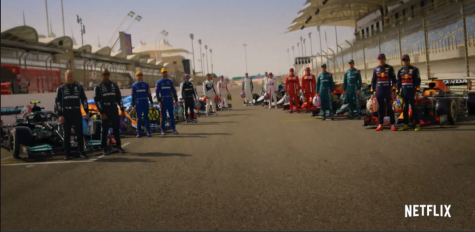Netflix’s ‘Formula 1: Drive to Survive’ offers entertaining, gripping insight on F1 racing
June 6, 2022

Boisterous celebrations, aggressive drivers and lightning-fast cars are taking over the streaming world through the highest, top-tier competitive racing division in Europe.
Netflix’s “Formula 1: Drive to Survive” follows this sport, offering a commercial, intense and captivating view on the competitive nature of F1 racing.
The docuseries has just released a fourth season chronicling the 2021 season, ramping up viewers and support for the popular European motor sport. The first season came out in 2016, and since then interest for both the league and the docuseries has increased. This season consists of 10 episodes, each averaging around 40 minutes in length.
This year’s coverage navigates the sophisticated dynamics of 10 teams and 20 drivers over the course of 22 Grand Prix races. The relationships between new and old team members and long-standing historical implications of past performances are explored. In some ways, the organization of the series is predictable, but the fact that it follows real occurrences adds interest and legitimacy.
Each episode opens with a hook that previews the episode, and the show is never lacking in ways to snatch your attention and speed away with it. Insight is provided by F1 experts such as specialized team leaders, CEOs, drivers and everyone in between.
Formula One is the highest league of formula racing, above the still-exclusive leagues of F2 and F3, and is in itself a multibillion-dollar business who’s commercial effect is massive. The show delves into the concept that winning is as much about beating other drivers and competition on track as it is navigating the tricky politics that come with the sport.
The docuseries does a nice job juxtaposing firsthand experience with action, making the audience feel as though they are in the driver’s seat or in the pit box with the crew, which adds interest and deflects boredom. The viewer serves as a bridge between the driver and team through the constant radio communication that occurs throughout the race while also hearing the echo of the announcer’s narration.
The program provides a good balance of documentary insight and dynamic racing action throughout the duration of the season. Though the main concept is about speed, the show never fails to employ a tense buildup that keeps you waiting, guessing and rooting.
Interestingly, some of the drivers in the sport reflect with disdain and annoyance on the show. They believe it portrays fake rivalries between teams and drivers, rivalries that seem to exacerbate pre existing tensions. This commercial deceit forms the basis of conflict within the show, but after all, isn’t that the best part?
Whether you are team Mercedes or Ferrari, a general fan of motor racing or just a curious new observer, “Formula 1: Drive to Survive” is sure to appeal to your curiosity, enlighten you on the sport and maybe even get you hooked in the real lifestyle of F1. As Max Verstappen from team Red Bull stated in episode 10, “As a driver, I’m only there to win. That’s the only thing that counts.”












Rob Wilkin • Aug 14, 2022 at 7:54 am
Excellent review!!